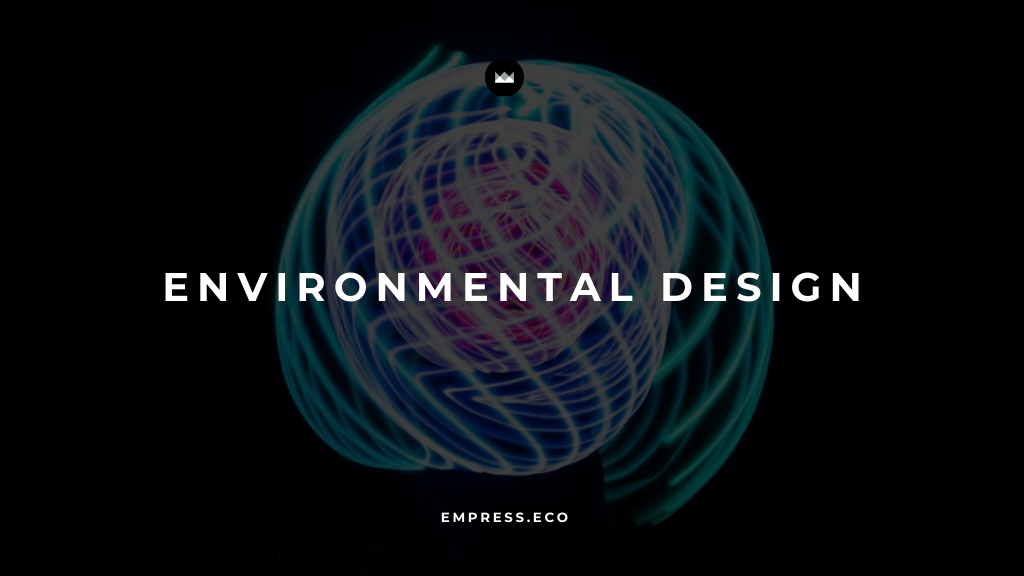
Environmental Design: Crafting Spaces that Embody and Elevate Brand Identity
Table of Contents
Environmental design has emerged as a crucial strategy for businesses seeking to translate their brand identity into physical spaces. Environmental design involves the deliberate creation of environments that not only reflect a brand's values and aesthetic but also engage and resonate with audiences on a deeper level. By integrating key brand elements into the very fabric of a physical space, companies can create immersive and memorable experiences that strengthen their brand presence and foster deeper connections with their audience.
The Power of Environmental Design
Environmental design is more than just aesthetics—it's about crafting spaces that tell a story, evoke emotions, and provide a tangible representation of a brand's identity. Whether it’s a retail store, an office, a showroom, or an event space, the environment should reflect the brand’s personality, values, and promise to its customers. By thoughtfully designing these spaces, businesses can create powerful, lasting impressions that go beyond traditional marketing tactics.
Key Benefits of Environmental Design
1. Strengthened Brand Identity
A well-executed environmental design reinforces brand identity by incorporating key brand elements into the physical space. This can include the use of logos, color schemes, typography, and even specific materials that are synonymous with the brand. When these elements are seamlessly integrated into the environment, they create a cohesive and recognizable brand presence that makes a lasting impression on consumers.
- Visual Consistency: A consistent visual identity across all touchpoints, including physical spaces, strengthens brand recognition. For example, Apple’s retail stores are instantly recognizable with their minimalist design, use of glass and steel, and the iconic Apple logo. This consistency reinforces Apple’s brand identity and makes the stores an extension of the brand experience.
- Tangible Brand Representation: Environmental design allows abstract brand values and messages to be represented tangibly. For instance, a brand that emphasizes sustainability might use eco-friendly materials, energy-efficient lighting, and plants to reflect its commitment to environmental responsibility.
- Brand Storytelling: Every element of the environment can contribute to the brand’s story. This could be as subtle as the choice of materials that convey quality and craftsmanship, or as explicit as murals or displays that depict the brand’s history and milestones.
2. Enhanced Customer Experience
Customer experience is at the heart of environmental design. A well-designed environment engages customers, draws them into the brand’s world, and leaves a lasting impression. When customers step into a space that resonates with them on an emotional level, they are more likely to develop a strong connection with the brand.
- Immersive Environments: By creating environments that are immersive and engaging, brands can captivate their audience. For example, Starbucks designs its stores to create a “third place” between home and work, where customers can relax, socialize, and enjoy their coffee in a welcoming atmosphere. This focus on the customer experience helps foster loyalty and repeat business.
- Interactive Spaces: Incorporating interactive elements, such as touchscreens, product demos, or virtual reality experiences, can enhance the customer’s engagement with the brand. These interactions not only make the experience more memorable but also allow customers to connect with the brand in a meaningful way.
- Comfort and Accessibility: Thoughtful design also considers the comfort and accessibility of the space, ensuring that all customers feel welcome and at ease. This includes considerations for seating arrangements, lighting, acoustics, and even scent—each contributing to the overall experience.
3. Increased Emotional Connection
Environmental design goes beyond the visual—it engages all the senses, creating a multi-sensory experience that evokes emotions and deepens the connection between the brand and its audience. When customers have a positive emotional experience in a brand’s space, they are more likely to form a lasting bond with the brand.
- Sensory Engagement: Engaging multiple senses can create a more immersive and memorable experience. For example, the use of scent in a retail environment can evoke specific emotions or memories that are associated with the brand. Similarly, background music can set the tone and mood, enhancing the overall atmosphere.
- Story-Driven Design: When a space is designed to tell a story, it can evoke a strong emotional response. For instance, a hotel lobby designed to reflect the local culture and history can create a sense of place and belonging for guests, making their stay more meaningful.
- Personalization: Spaces that can be tailored to the individual, such as customizable lighting or interactive displays that respond to the user, can create a sense of personal connection with the brand. This level of personalization makes customers feel valued and understood.
4. Differentiation in the Marketplace
In an increasingly crowded market, standing out is crucial. Environmental design provides an opportunity for brands to differentiate themselves by creating unique and memorable spaces that attract attention and leave a lasting impression.
- Unique Design Elements: Incorporating unique and innovative design elements can make a space stand out. For example, the Nike House of Innovation in New York City features a dynamic space with customizable products and interactive experiences that highlight the brand’s commitment to innovation.
- Memorable Experiences: A well-designed space can create a memorable experience that customers associate with the brand. Whether it’s a pop-up shop that creates buzz or a flagship store that becomes a landmark, these spaces can become powerful marketing tools.
- Brand Ambassadors: Customers who have a positive experience in a brand’s space are more likely to share that experience with others, either through word-of-mouth or social media. This organic promotion can help the brand reach new audiences and reinforce its presence in the market.
Implementing Effective Environmental Design
To successfully create spaces that embody and elevate brand identity, businesses need to approach environmental design with a clear strategy that aligns with their overall branding efforts. The following strategies can help companies effectively integrate brand elements into physical spaces:
1. Integrate Brand Elements
The first step in effective environmental design is to integrate key brand elements into the physical space. This includes the use of logos, color palettes, typography, and other visual identifiers that are consistent with the brand’s overall identity.
- Visual Identity: Ensure that the space reflects the brand’s visual identity. This could involve using the brand’s signature colors in the décor, incorporating the logo into the design in subtle or bold ways, and using consistent typography on signage and displays.
- Brand Materials: Consider the materials used in the space as an extension of the brand. For example, a brand that emphasizes luxury might use high-end materials like marble or leather, while an eco-friendly brand might opt for recycled or sustainable materials.
- Cohesive Design Language: The design language of the space should be cohesive and aligned with the brand’s overall aesthetic. For instance, a tech company might use sleek, modern lines and minimalistic design to convey innovation and forward-thinking.
2. Focus on Sensory Engagement
To create a truly immersive environment, it’s important to engage multiple senses. Sensory engagement can enhance the emotional impact of the space and make it more memorable for customers.
- Sight: Visual elements are the most obvious aspect of environmental design, but they should be carefully considered to ensure they reflect the brand’s identity. This includes not only colors and logos but also lighting, layout, and overall aesthetics.
- Sound: The choice of background music or soundscapes can significantly influence the atmosphere of the space. For example, a spa might use calming music to create a relaxing environment, while a trendy retail store might play upbeat tracks to energize shoppers.
- Touch: The textures and materials used in the space can also play a role in the customer experience. Soft, plush seating can create a sense of comfort, while smooth, polished surfaces might convey a modern, sleek aesthetic.
- Smell: Scent marketing is a powerful tool that can evoke emotions and memories. A consistent scent across all brand environments can create a strong sensory association with the brand.
3. Align with Brand Values
A key aspect of environmental design is ensuring that the space aligns with the brand’s core values. This alignment not only reinforces the brand’s identity but also enhances authenticity and trust with the audience.
- Reflecting Values: The design of the space should reflect the brand’s values and mission. For example, a brand that values sustainability might incorporate energy-efficient lighting, eco-friendly materials, and greenery into the design.
- Cultural Sensitivity: If a brand operates in multiple regions, the environmental design should respect and reflect local cultures while staying true to the brand’s identity. This balance can strengthen the brand’s connection with local customers.
- Purpose-Driven Design: Spaces can also be designed to reflect the brand’s purpose or social initiatives. For example, a brand that supports education might create spaces that include learning areas or resources for the community.
4. Leverage Technology
Technology can play a crucial role in enhancing environmental design by creating dynamic and interactive environments that engage customers in new and innovative ways.
- Digital Displays: Incorporate digital displays that can be updated in real-time to reflect new promotions, products, or messages. This flexibility allows the space to stay relevant and fresh.
- Interactive Installations: Use interactive technology, such as touchscreens, VR experiences, or augmented reality, to engage customers and make the space more interactive. For instance, a car showroom might use AR to let customers visualize different car models with various customizations.
- Smart Technologies: Implement smart technologies that can adjust lighting, temperature, or music based on the time of day or customer preferences. These technologies can create a more personalized and comfortable experience.
5. Consider Sustainability
Incorporating sustainable design practices into environmental design not only reflects a commitment to environmental responsibility but can also enhance the brand’s reputation and appeal to environmentally conscious consumers.
- Eco-Friendly Materials: Use sustainable materials, such as recycled wood, bamboo, or reclaimed metal, in the construction and furnishing of the space. These materials not only reduce environmental impact but also align with a growing consumer preference for sustainable products.
- Energy Efficiency: Design spaces with energy efficiency in mind, using natural lighting, energy-efficient lighting systems, and smart HVAC systems. This approach not only reduces operational costs but also demonstrates a commitment to sustainability.
- Waste Reduction: Implement practices that reduce waste, such as using modular furniture that can be easily reconfigured or recycled, or incorporating waste sorting and recycling stations into the space.
Challenges and Considerations in Environmental Design
While environmental design offers significant benefits, it also presents certain challenges that businesses must navigate to ensure successful implementation.
1. Resource Intensive
Designing and implementing effective environmental design projects can be resource-intensive, requiring significant time, budget, and expertise.
- Budget Management: Environmental design projects can be expensive, particularly if they involve custom elements or cutting-edge technology. Businesses must carefully manage their budgets to ensure that the project stays on track financially.
- Time Commitment: Environmental design is a time-intensive process, from initial concept development to final execution. It’s important to allocate sufficient time for each phase to avoid rushed decisions or compromises on quality.
- Expertise and Collaboration: Effective environmental design often requires collaboration between various experts, including designers, architects, brand strategists, and technology specialists. Ensuring clear communication and coordination among these teams is crucial.
2. Maintaining Consistency
Ensuring consistency across different spaces and touchpoints while allowing for local adaptation can be challenging.
- Brand Guidelines: Clear and comprehensive brand guidelines are essential to maintaining consistency across all spaces. These guidelines should outline the use of visual elements, materials, and design language.
- Adaptability: While consistency is important, spaces should also be adaptable to local cultures and contexts. This requires a balance between adhering to brand standards and allowing for customization where appropriate.
- Quality Control: Regular monitoring and quality control checks can help ensure that the design is implemented consistently across all locations.
3. Measuring Impact
Evaluating the effectiveness of environmental design in terms of brand engagement and customer experience can be complex.
- Feedback Mechanisms: Implement feedback mechanisms, such as customer surveys or focus groups, to gather insights into how the space is perceived and experienced by customers.
- Data Analytics: Use data analytics to track customer behavior within the space, such as time spent in different areas or interactions with specific elements. This data can provide valuable insights into the effectiveness of the design.
- ROI Analysis: Assess the return on investment (ROI) of the environmental design by measuring its impact on key metrics such as foot traffic, customer satisfaction, and sales.
Conclusion: The Future of Environmental Design
Environmental design is more than just creating visually appealing spaces—it’s about crafting environments that embody a brand’s identity, engage the senses, and create meaningful connections with customers. By integrating brand elements into physical environments, businesses can enhance customer experiences, strengthen brand recognition, and foster deeper connections with their audience.
As the importance of brand identity continues to grow in a competitive market, effective environmental design will be essential for businesses seeking to differentiate themselves and achieve long-term success. By focusing on sensory engagement, aligning with brand values, leveraging technology, and considering sustainability, companies can create spaces that not only stand out but also resonate with consumers on a profound level.
In summary, environmental design offers:
- Strengthened brand identity through the integration of key brand elements into physical spaces.
- Enhanced customer experiences by creating immersive, engaging environments that resonate with audiences.
- Increased emotional connection by engaging multiple senses and creating memorable experiences.
- Differentiation in the marketplace by offering unique and well-designed spaces that attract attention.
By embracing these strategies, businesses can use environmental design to elevate their brand identity and create spaces that truly embody who they are.
Empress Newsletter
Join the newsletter to receive the latest updates in your inbox.



